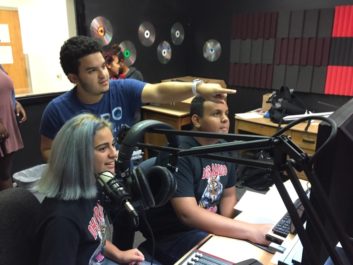
A media professional since 1972, I eventually found myself in south Florida in the new millennium, working as an audio engineer for the Miami Dolphins and the Florida Marlins. A move to central Florida several years later forced me out of the media business and into education, where I have been ever since.
At Dunnellon High School, I teach intensive reading to seniors and AP world history. The reading students who motivated me to create a “reading for radio” program about five years ago.
I had been searching for an incentive to motivate students to improve their technical reading skills and, of all things, a 250-foot radio tower on our campus sparked the process. Although used by the transportation department, I looked into an LPFM license for the school and was encouraged, until I started the budget — no way! As most readers will know and understand, we in education barely have enough money for essentials, not to mention trying to fund a project like that.

[Community Broadcaster: College Radio Shows the Way]
But the idea of combining radio with the academic needs of my reading students still seemed like a great concept. Imagine, having a school radio station run by students and then opening the on-air auditions to students who are struggling as readers.
I started researching internet radio, and suddenly this idea had legs. Still, funding would be a challenge, but it would be nothing like the cost of trying to implement an over-the-air presence.
This is where CenturyLink Communications entered the picture. The company sponsors an annual grant competition through its Clarke M. Williams Foundation. These grants are open to public school teachers who blend technology and academics to benefit their students.
It seemed like a perfect fit. However, as a traditional broadcaster, I had a significant learning curve ahead, trying to wrap my head around a new-to-me, method of delivery.
I applied for the grant in the fall of 2015 and received word that I had been successful in April 2016. My first reaction was: “Now that I have the money, you mean I actually have to do this?!”
GETTING OFF THE GROUND
I spent the entire summer of that year doing the research; and there was plenty of it.
First, investigating what the technical aspects of putting a station on the internet was all about. What, if any, were the government regulations; what licensure was required; how are royalties covered — basically learning how all the pieces fit together.

Next, of course, came a design and a location within the school. The administration came through with an unused office, and I designed the equipment configuration around that space.
Next came a meeting with the school system’s head of IT to explain the project and learn if the infrastructure would support streaming within the school (bandwidth being the potential problem). I explained that we would be sending our outbound signal to a web hosting company for streaming and that our IT requirements were minimal. One potential problem eliminated.
Next, I had to survey and select equipment that would meet our needs at a reasonable cost. I enlisted the help of Guitar Center Pro and found them to be very helpful in the selection process.
[College Radio Station Flies Overseas for Remote Broadcast]
Finally, I needed to find a software automation system that would fit our needs and our budget. You probably know that this market has become very active in the last few years, and there are dozens of products to choose from in every price range. I was fortunate to come across a talented young developer in Texas who has created a program called NextKast Pro. The program is sold as a download with program key and is incredibly reasonable and both powerful and flexible.
The studio is broken into two halves utilizing two Windows-based PCs. One is dedicated to running the NextKast software and is our “broadcast” computer. The other is our “production station,” utilizing an Allen & Heath analog mixer, Shure and AKG studio mics and Audacity editing software for our production needs.

The last piece of the puzzle was our access platform. We have chosen TuneIn Radio utilizing either their mobile app or their internet presence at www.tunein.com.
At the beginning of the 2016-17 school year, students first were recruited to join “The Growl” (We are the Dunnellon Tigers, hence the name). Our goal was to get on the air prior to Christmas break. On Dec. 13, 2016, “The Growl” went live for the first time and has been on 24/7 since. Our format is eclectic as we attempt to provide both music of all genres and some very creative original student programming (written, produced and performed by our students).
For information contact Barry Carrus at [email protected]. Radio World welcomes stories about the creation and building of your radio station or media facility. Email [email protected].












